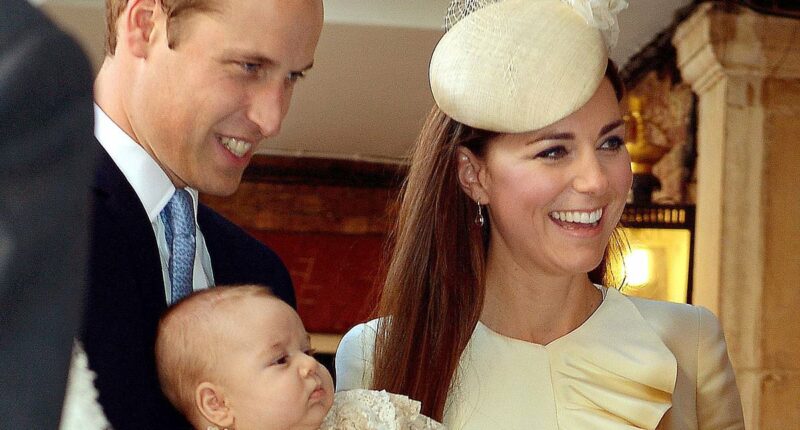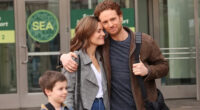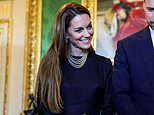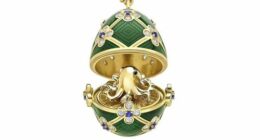Share this @internewscast.com
As the future King and Queen Consort of England, Prince William and Kate Middleton are well-acquainted with adhering to the traditions of the Royal Family.
However, in a nod to their apparent dedication to ushering in a more contemporary monarchy, the couple decided to break away from one age-old tradition during the christening of their cherished son, Prince George.
On July 22, 2013, the world learned of the birth of William and Kate’s first child through a wood-and-gold easel that made the announcement official.
To celebrate the occasion, the bells of Westminster Abbey rang, landmarks were bathed in blue light to signify the birth of a boy, and ceremonial gun salutes took place in London, Bermuda, New Zealand, and Canada.
Just three months later, the young prince was baptized at the Chapel Royal in St James’ Palace. This significant event was the first in nearly 120 years where four generations of the Royal Family’s line of succession were captured in a single photograph.
Prince George was dressed in a custom-made replica of the christening gown originally worn by Queen Victoria’s daughter. According to royal expert Valentine Low in his book “Courtiers,” the young prince was reportedly “on his best behaviour” during the ceremony.
And in keeping with royal tradition, the young Prince was christened using the ornate 175-year-old historic Lily Font, while water from the River Jordan was also used.
Then, following the service, the new parents hosted a private tea at Clarence House, with guests served slices of christening cake from a tier taken from William and Kate’s wedding cake.

In an indication of Prince William and Princess Kate’s seeming commitment towards embracing a new, modern era of Monarchy, the Royal couple chose to break one historic custom during the christening of their beloved son, Prince George

Following the birth of Prince George, just three months later the young Prince was christened in the Chapel Royal at St James’ Palace. The event marked the first time in nearly 120 years that four generations of the Royal Family ‘s line of succession had been pictured together
But despite following a number of historic traditions, there was one exemption that indicated a stark shift in Royal protocol.
As Mr Lowe explains, ‘it was, in many respects, a very traditional royal christening.’ However, the young Prince’s seven godparents, which featured just one Royal ‘represented something of a break with tradition’.
While historically, Royal children were bestowed with strictly Royal godparents, some of whom were even blood relatives, young Prince George was to be quite the exception, marking the beginning of a modern era of Royalty.
Instead, just one member of the Royal Family made the cut – Zara Tindall, who did not herself even possess a title.
Her choice as godmother seems somewhat unsurprising given that her and William have shared a special bond that has been evident since their childhood.
William, alongside his brother Harry, were both raised just a few miles from where Zara and her brother Peter grew up in Gloucestershire, with the four royal cousins were often spotted chatting and joking at royal events.
The Prince has previously revealed how it was ‘hard to keep a straight face’ when sitting opposite his cousins in church. Born just 13 months apart, Zara was reportedly a great comfort to William after his mother Diana’s death in 1997.
Though she may not be a working royal and has experienced less media attention than William and Harry, the royal cousins have become protective of each other over time.

On July 22, 2013, a wood-and-gold easel announced the birth of William and Kate’s first child to the world. The bells of Westminster Abbey rang out and landmarks were illuminated blue to symbolise the birth of a boy

While historically, Royal children were bestowed with strictly Royal godparents, some of whom were even blood relatives, young Prince George was to be quite the exception. Instead, just one member of the Royal Family made the cut – Zara Tindall, who did not even possess a title
In a Channel 5 documentary, ‘Zara & Anne: Like Mother Like Daughter’, Victoria Arbiter said: ‘For William in particular, trust is everything so when you’ve got a cousin that understands what it is to be a member of the Royal Family, but they don’t have the same pressures associated with it, they can be a tower of strength and support.’
But in contrast to Royal tradition, Zara was not joined by any other members of the Firm when Kate and William carefully selected their young son’s new godparents.
Instead, she was joined by six of Kate and William’s close friends and family members, including Oliver Baker, Hugh Grosvenor – the Duke of Westminster, Emilia Jardine-Paterson, Julia Samuels and William van Custem.
In a rather remarkable twist and an even greater defiance of protocol, the most noteworthy individual on the godparent list was Jamie Lowther-Pinkerton, former private secretary to Kate and William.
While at the stage of George’s christening he had stepped down from his former role, he was still working one day a week as an adviser to the Prince and Princess, alongside Harry.
Explaining why opting to select Mr Lowther-Pinkerton as a godparent had been such an unconventional move, Mr Lowe wrote: ‘It is an absolute article of faith with just about every private secretary that I spoke to for this book that the relationship between adviser and principal is surely professional.
‘But Jamie Lowther-Pinkerton was their friend. He had been there at the very beginning, before they had their own household, when it was just him and Helen Asprey.
‘He was their confidant, their mentor, their older brother.’

Zara’s choice as godmother seems somewhat unsurprising given that her and William have shared a special bond that has been evident since their childhood. William, alongside his brother Harry, were both raised just a few miles from where Zara and her brother Peter grew up

In an even greater defiance of protocol, the most noteworthy individual on Prince George’s godparent list was Jamie Lowther-Pinkerton (pictured leaving the christening with his wife), former private secretary to Kate and William
Yet, given his professionalism, Mr Lowe was almost certain that he ‘would never have said he was William’s friend when he was working for him’.
Selecting their former private secretary as one of many godparents to their newborn was a slightly abnormal rule break for a Royal couple, yet he was not the only individual in that list to raise slight eyebrows.
Indeed, while royal babies traditionally have six godparents, the young prince was given a total of seven and they even included some of his parent’s most valued friends and confidants, rather than fellow Royals.
As a friend of William from his teenage years and a schoolfriend of Kate from her time at Marlborough College, Emilia Jardine-Paterson has often been credited with introducing the Prince and Princess of Wales to one another.
Their close bond is perhaps even further solidified by the fact that her husband David Jardine-Paterson, even dated Kate’s sister, Pippa, for four years.
Meanwhile, another godparent, Oliver Baker, was also a close friend of the couple – having attended St Andrews University at the same time as the Royal lovebirds.
Following their university days, Oliver’s wife shared the Middleton family flat in Chelsea with Kate.
A loving and poignant tribute to William’s beloved mother, British psychotherapist Julia Samuels, a close friend of the late Princess of Wales, was also selected to be a part of the high-ranked list.
Having first met the late Diana at a dinner party in 1987, Ms Samuels was called upon to provide the young Prince with an essence of his grandmother’s audacious and lighthearted spirit.

A loving and poignant tribute to William’s beloved mother, British psychotherapist Julia Samuels (pictured), a close friend of the late Princess of Wales, was also selected to be a part of the high-ranked list

Indeed, their decision to go against the Royal norm when it came to grandparents may be indicative of their broader desire to raise the young Prince, alongside his siblings – Princess Charlotte and Prince Louis, with a more ‘normal childhood’
Speaking on the How to Fail with Elizabeth Day podcast last year, she revealed that she buys the ‘feisty and cheeky’ young royal ‘impossible’ noisy toys that take the Prince of Wales ‘days to put together’ in a running joke inspired by Diana.
And in response to being asked whether she was a ‘good’ godmother to George, she recalled being ‘pretty good’.
Yet William and Kate’s unconventional selection of godparents for George was not to be the only time they would subtly revamp the historic Royal style, but rather an indication of their move towards a more contemporary Firm.
Indeed, their decision to go against the Royal norm when it came to grandparents may be indicative of their broader desire to raise the young Prince, alongside his siblings – Princess Charlotte and Prince Louis, with a more ‘normal childhood’.
George’s birth coincided with the end of the centuries-old tradition of primogeniture which previously dictated that the first born son would take the throne and that any resulting spare must be succeeded by the next born male.
The result is that William’s daughter and sons are less likely to suffer from the same bitter ‘rift’ both him and Harry have fallen victim to, Royal insiders have claimed.
Ten-year-old Charlotte, will be the first to benefit from the long-needed update, which previously sidelined Princess Anne and made Prince Andrew the spare to Charles.
And, according to Tom Quinn, historian and author of Scandals Of The Royal Palace, ‘It will make things a lot easier because there won’t be two males like two deer clashing antlers anymore.’
Both William and Kate have also signified a new era of open affection for the Royal Family by deliberately breaking away from the traditional ‘stiff-upper lip’ mentality traditionally favoured by previous generations of the Firm.

George’s birth coincided with the end of the centuries-old tradition of primogeniture which previously dictated that the first born son would take the throne and that any resulting spare must be succeeded by the next born male. Ten-year-old Charlotte, will be the first to benefit
Indeed, William’s intentional embrace of emotion was showcased by heartbreaking recent footage of the future King being brought to tears as he spoke to a grieving mother whose husband took his own life just days after their one-year-old son died.
In a deeply moving conversation to mark World Mental Health Day, the Prince of Wales’s voice broke and he squeezes his eyes shut as Rhian Mannings told him how she desperately wished her late husband, Paul, had spoken to her about how he was feeling.
‘I think that’s what the hardest thing is… we would have been OK,’ she said.
And, according to brand and culture expert Nick Ede, the Prince and Princess of Wales are deliberately ‘rebranding’ the Royal Family in a new era by tactfully showing a ‘more human side’ to the family.
He previously told the Daily Mail: ‘When Meghan and Harry were part of the Sussex royal brand they cleverly used social media to communicate, and I think that the Prince and Princess saw this trend as something they should adopt.’
Mr Ede suggests that the couple are seeking to balance consistency with modernism in a bid to ‘keep the positive appeal of the Royal Family alive’.
Meanwhile, the Princess of Wales has also garnered a reputation for being unafraid to break Royal protocol, reportedly ‘putting her foot down’ to stop her children from being required to partake in a centuries-old ‘blooding tradition’.
In Yes, Ma’am – The Secret Life Of Royal Servants, author Tom Quinn revealed that Kate had insisted that her three kids not take part in an ancient practice.

According to brand and culture expert Nick Ede, the Prince and Princess of Wales are deliberately ‘rebranding’ the Royal Family in a new era by tactfully showing a ‘more human side’ to the family

Kate has also garnered a reputation for being unafraid to break Royal protocol, reportedly ‘putting her foot down’ to stop her children from being required to partake in a centuries-old ‘blooding tradition’
The ritual sees young royals going shooting – then having their faces ‘smeared with the blood of his or her first kill’ (either a stag or a fox).
But Kate, who is known to have complicated feelings towards blood sports, was adamant that Princes George, 12, and Louis, seven – as well as Princess Charlotte, ten – avoid enduring the gory convention.
Mr Quinn recounted: ‘Charles’s daughter in-law, Catherine, Princess of Wales, has put her foot down and insisted there will be no blooding for her children.’
Indeed, according to royal expert Richard Fitzwilliams, it is the future King and Queen’s relatability and seeming lack of fear to go against royal protocol that will help to ensure that the monarchy is fit to service in the 21st century.
Mr Fitzwilliams added: ‘William also wants to change things and modernise aspects of the monarchy, whilst maintaining relevant traditions which are valuable such as the Opening of Parliament and Trooping the Colour.’
Throughout his time as a working royal, William has showcased his down to earth attitudes on multiple occasions.
In 2013, the then-Duke of Cambridge played football on the lawn of Buckingham Palace with Pride of Britain award winner June Kelly and legendary England striker Michael Owen on the lawn of Buckingham Palace.
And in 2022, he was seen hugging England Women’s players following their historical Euro win, a direct defiance against the age-old rule within the Firm that members of the institution typically shook hands with members of the public.

Throughout his time as a working royal, William has often showcased his down to earth attitude. In 2022, he was seen hugging England Women’s players following their Euro win, going against the age-old rule that members of the Firm typically shook hands with the public

Harry’s mother Diana, the People’s Princess, was never afraid of going against the norm and broke royal protocol on numerous occasions, including her notorious ‘revenge dress’ and even partaking in Prince Harry’s sports day
But Mr Fitzwilliam added that the Prince’s ‘more relaxed public appearances have delighted onlookers’, while other royal experts have noted that William’s willingness to engage with the public in a more casual manner is somewhat reminiscent of his late mother’s behaviour.
Diana, the People’s Princess, was never afraid of going against the norm, breaking royal protocol on numerous occasions, with notable examples including her notorious ‘revenge dress’ and even partaking in Prince Harry’s sports day.
When the late Diana tragically died following a fatal car crash in the city of Paris in 1997, the world mourned the loss of the modern Princess who resonated so deeply with the nation.
Yet as we look towards a new era of Monarchy – the late Princess’ compassionate and down-to-earth spirit has undoubtedly lived on through her eldest son.
And as William himself now continues on the complex yet joyous adventure of parenthood, it seems he too is seeking to instill these qualities in the young Prince George, who one day will take on the role of King.










